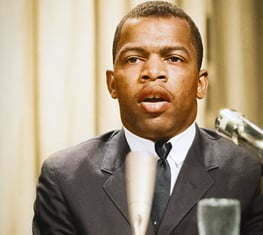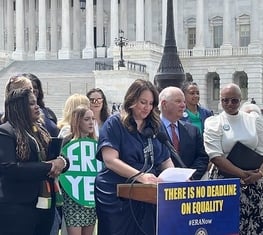Leadership Team Structure and Operations
You can run your League with a streamlined management structure.
You can run your League with a streamlined management structure. You do not need to hold to the traditional model of a League board. The streamlined Leadership Team structure makes it possible for as few as four League leaders to simply manage the work of the League. The basic Leadership Team positions include:
- Spokesperson/Convener
- Money Person/Treasurer
- Webmaster
- Member Coordinator
- An Advocacy Person can be added if desired.
Of course, it is permissible and even desirable to welcome additional participants on your Leadership Team – it’s a great way of growing future leaders and building the capacity of your League. As you build momentum, you might add a fundraising specialist or a program coordinator or others. (See Leadership Team Building and Succession Planning, below.) But you can get started with as few as four.
Leadership Team Meetings. The Leadership Team will want to meet at least quarterly. These team meetings are the time to discuss and coordinate the events and activities that you have planned in your calendar. Each team member reports on their area of responsibility (see Job Descriptions) and any other responsibility they have agreed to take on.
Traditional Leagues usually an Annual Meeting of members in the spring. Streamlined Leagues can hold an annual business meeting whenever it is best. This meeting is to allow the membership to approve a new Leadership Team, budget and any program recommendations. It can be a short concise meeting or you can use it as a membership meeting and provide a speaker or other item of interest to draw them to attend.
Members are welcome at their Leadership Team meetings. Make sure members know when and where the meetings are held, and give members an opportunity to participate at the meetings, if they desire. The state League should have a liaison or coach that stays connected with and supports streamlined Leagues.
It’s good to have an agenda for Leadership Team meetings. An agenda allots time logically and helps Leadership Team members prepare for team meetings. It is sent out prior to the meeting, along with previous meeting minutes, a financial report, any other material that members are expected to review and discuss at the meeting. Typically, the Convener creates the agenda, but some teams take turns sharing responsibilities of writing the agenda and conducting the meeting.
It’s also important to keep basic minutes of the Leadership Team meetings. Leagues need an official record of League business. The minutes are the record of League decision-making, and minutes let absent members know what happened at the meeting. Good minutes are short and contain:
- The name of the League, date, time and place
- The names of those present, those absent
- A record of all corrections to the minutes
- A money person/treasurer’s report (previous balance, income and expenditures, current balance)
- A report from other team members which are attached to minutes
- A record of decisions made and by whom
Leadership Team Building. When a new leadership team is getting started or when new members join the team, it’s a good idea to spend a little time on team building. Again, here’s a place where the state League may be helpful. A good team building orientation informs Leadership Team members about the League, acquaints them with one another, and builds a sense of total team responsibility. New members gain confidence in carrying out their responsibilities and learn how the League and the team work. The exchange of ideas and experiences with League peers can build comradery and confidence among team members. Local Leagues may conduct their own orientation sessions, call on seasoned local League leaders, request state League assistance, or in some states, participate in statewide sessions planned on a regular schedule.
This is the time to review job responsibilities, budgets, operating rules, membership status, etc., and to revisit the basic principles of the League and nonpartisanship. It is a good time to check that outgoing team members have passed on files and materials needed for continuity of responsibilities.
Budget. A budget is a planning instrument that reflects the goals, priorities and activities planned for the year. In the Streamlined League, the Leadership Team develops the budget and provides an opportunity for membership input. Appendix Q has a “Sample League Budget “ for you to use. A well-conceived, realistic budget accomplishes the following:
- Reflects all anticipated income and expenses for a fiscal year
- Shows planned growth in members, dues, contributions, and League activities
- Realistically plans for expenses, e.g. events, activities, funds to help pay for sending delegates to state and national conventions (an important investment in the League’s future)
- Reflects each League’s obligation to support the League at all levels
The Budget is approved by the membership at the Annual business meeting.
POLICIES
Each new Leadership Team must adopt a Nonpartisan Policy. Since the Leadership Team is a small group of League leaders and they are working together on all aspects of the League, the Nonpartisan Policy should cover all members of the Leadership Team. A “Sample Streamlined League Nonpartisan Policy” is included as Appendix R.
The policy should include specific guidelines to govern the political activities of Leadership Team members:
- A statement of the nonpartisan nature of the organization
- Guidelines on permissible activities for Leadership Team members
- How to handle situations when a board member decides to engage in political activity.
Your Leadership Team can adopt other polices as needed before a problem arises. Some of these policies are "Conflict of Interest", "Candidate Debates", "Making Decisions between Board meetings", and "Coalitions". There are sample policies available on the LWVUS website, www.lwv.org.
BYLAWS
Streamlined local Leagues function like other Leagues under a standard set of operating rules or bylaws that tell the League’s Leadership Team what is expected, required, and allowed.
It is not necessary to change your League’s Bylaws immediately if you are trying the Streamlined League model. Your League can conduct a trial period operating with the streamlined format and change the Bylaws when ready at your Annual business meeting.
It is also an option for your League to return to operating with a more traditional model of a board and bylaws if so desired.
LEADERSHIP DEVELOPMENT
The Leadership Team is the organization’s administrative and policy-making team and plays an essential and primary role for a successful League. The Leadership Team is collectively responsible for all team decisions, plans, and activities for development, membership, voter services, visibility, financial welfare, and program.
In addition to all this, the process for recruiting and training new members to do this important teamwork also falls to the Leadership Team. (A more traditional League would have a Nominating Committee, but in the streamlined League, the Leadership Team is self-sustaining.) One of the Leadership Team’s primary roles is to have a deliberate, structured, and proactive plan in place for developing a constant pool of qualified, trained and willing volunteers.




